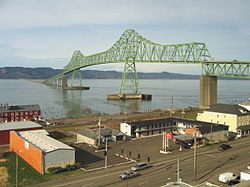
This list of continuous bridge spans ranks the world's continuous truss bridges in two listings: The first is ranked by the length of main span (the longest length of unsupported roadway) and the second by the total length of continuous truss spans.
Contents
- List ranked by length of main span
- List ranked by total length
- History of the record span
- References
- Footnotes
Both lists include bridges that act primarily as a continuous truss. These bridges may appear to be—or may incorporate elements of—a different design. For example, the now destroyed Francis Scott Key Bridge incorporated an arch shape into the design, but was continuous across multiple spans. The Key Bridge acted first as a continuous truss bridge and secondarily as an arch bridge. This list does not include cantilever bridges.
Only bridges that are currently in use are included in the rankings. Bridges currently being planned, designed, or constructed and bridges that have been destroyed or demolished are noted separately.


























